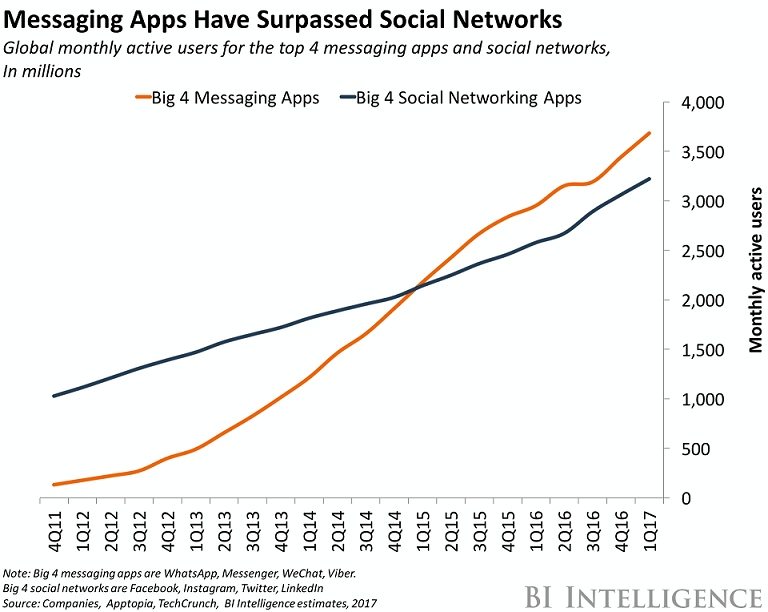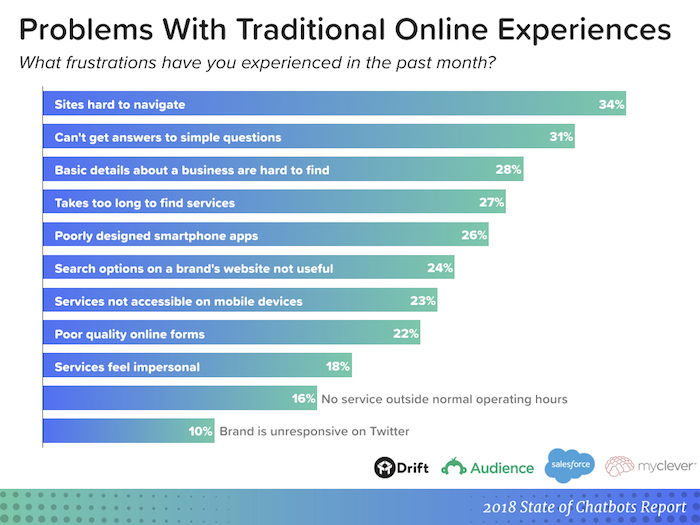Chatbots – the communication of the future
By Pablo Iturra
If you thought chatbots were something only used for B2C customer support - think again. In a not too distant future, 85% of our relationship with an enterprise might be carried out without ever interacting with a human. Chatbots are easy to implement and an effective way to serve your users with information 24/7. They are also an excellent ways of collecting data that can help improve your communication, customer support and offering.
The use of chatbots is growing massively and the process goes hand in hand with users abandoning social networks and heading for 1:1 communication instead. According to Gartner, by 2020, customers will manage 85% of their relationship with an enterprise without interacting with a human. Conversational marketing will be a recognised channel of B2B and B2C customer engagement and revenue, displacing a combination of marketing, sales and service activities.

http://www.businessinsider.com/the-messaging-app-report-2015-11
3 reasons why chatbots are growing
1. Users do not want to install more apps
Users are tired of downloading yet another app that will only fulfil one of their needs. The steps for ordering a flower delivery or a cab are the same, and wouldn’t it make life easier if you could handle that on a single platform that you already own? Current messaging platforms like Facebook Messenger, WhatsApp, WeChat etc. are stronger when it comes to the number of users, features and market position. For example, there are currently more than 300,000 active chatbots on Facebook’s Messenger.
2. Language is the most natural interface humans understand, and that’s the interface that chatbots use
Users are getting used to communicating in a talkative way, and that includes both writing in a chat and talking to voice assistants like Alexa and Siri.
The amount of search results and the size of websites themselves are growing. Thus, trying to find the right information is becoming more and more difficult. It means the user might be asked to make many decisions about which path to choose (click) in a menu to reach the required information. The user can end up getting lost, having to start over or just give up. But creating a conversation and following a chat is easier and faster than navigating across a complex (and always growing) website structure.

https://www.drift.com/blog/chatbots-report
3. Multitasking, mobile phones and time
Users are also getting used to do whatever they need to do online at any time of the day or night, during work hours or their spare time. Users no longer find it a problem to – and would expect to be able to – both play Candy Crash and buy a ticket for their next vacation on a mobile phone at 3 AM on their way home from a party. Having a chatbot gives the user a 24/7 service which can answer questions while also giving a specific user a better deal.
What is it and how to use it
A service that is powered by rules and sometimes artificial intelligence, that a user can interact with via a chat interface – that is the definition of a chatbot. It can be used for many different purposes, ranging from functional to fun.
Acquire new users/customers
A chatbot can be used to start a conversation with users and get more information in order to define a better funnel. It doesn’t necessarily have to be placed on your home page. Sometimes, adding it in deeper in the structure, where you know that your users have a lot of questions, will achieve a better result. It can be set to initiate a conversation based on the time the user has spent on the website or for visits outside of work hours, when regular support is not available.
Engage the users/customers
Chatbots can also be used to engage your users in a proactive way. By asking if the user needs any help and providing tips and/or more information relevant to what they are doing, you are more likely to build a long-term relation with them.
Provide your users with 24/7 support
As mentioned earlier, one of the reasons why chatbots are growing so quickly is the fact that users are becoming less bound to scheduled hours. Offering support and answering questions 24/7 can be scaled very easily. The more you learn from your chatbot, the easier you can hone it to provide even more accurate answers or send the user to more relevant content, depending on the user’s level of knowledge.
All these ways of using chatbots are also excellent sources for collecting data. When analysed and used in decision making, these data sets can help improve your communication, customer support and offering. The type of questions asked to a support chatbot can help you gain insight on what content you lack or what could be improved. You can offer discounts to certain segments, fast lane support for premium users or quicker direction to in-depth reading for a user that is obviously way past the basics.
How to start – and, help please?
A first step is to decide whether you want to use a chatbot in a passive or proactive way. A more passive way could be to find out which set of questions might be the same for a lot of people at the same time and answer that with the bot. It will save you customer support time and hopefully increase customer satisfaction.
A more proactive approach is to identify the triggers for what a user might need help with, as well as when this might happen, and have the bot provide a solution - maybe even before they ask. This demands a bigger effort, requiring pre-studies and comprehensive testing of real users. However, compared to the slightly more passive approach, this will create more value for your user and build a longer-term relationship.
Comprend is here to help. With user experience designers, developers, analysts, content creators and an agile work way of working, we have what is needed to find the right triggers, design a tonality and precise dialogue, perform user tests, implement and follow up.
Want to talk more about chatbots? Please contact:



